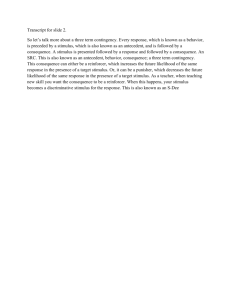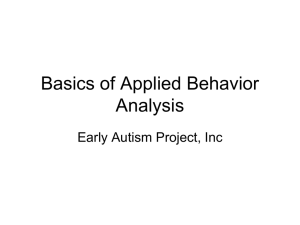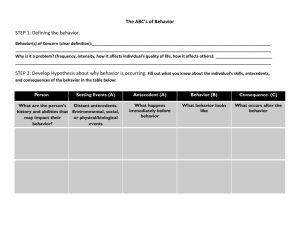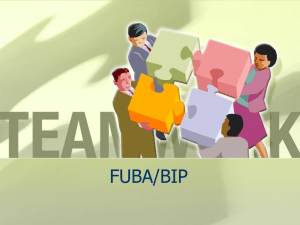Document
advertisement
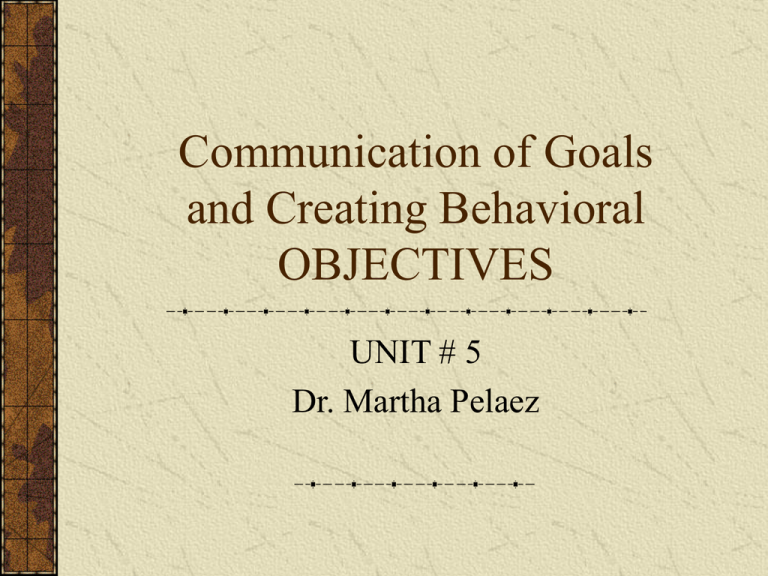
Communication of Goals and Creating Behavioral OBJECTIVES UNIT # 5 Dr. Martha Pelaez Communicating Expectations One of the best ways to manage behavior in the classroom is through explicit communication of expectations Remember, effective classroom management is comprehensive It includes • • • • Organizing classroom space Time management Positive classroom rules Explicit communication of expectations Communicating expectations A teacher communicates her expectations through words as well as actions Classroom rules Student goals and objectives Your daily objectives for each lesson should be written on the chalkboard so student will know what they are going to learn Goals Goals are broad statements about the direction of change in behavior David will learn to read at a second grade level Sara will add two digit numbers Objectives Objectives identifies a proposed change in behavior Describe a level of performance and serve as the basis for evaluation During science class David will read a paragraph orally in two or less minutes with less than two omissions or substitutions on 5 of 5 occasions Given a set of 25 two digit additions problems Sara will write the correct sum to 23 or more problems on 5 of 5 occasions Components of a behavioral objective Identify the learner Identify an observable target behavior Identify the conditions under which the behavior is to be displayed Identify criteria for acceptable performance Observability of action words Action words that are directly observable Cross out Mark Place Cover with Draw Repeat Cross out Circle Press a card Count orally orally Write Underline Say Read Label Name Put on Choose orally Shade Remove Action verbs that are not directly observable Understand Perceive Know Discover Think Discriminate Generate Discriminate Feel Think Conclude Appreciate Analyze Deduce critically Infer STOs Short term objectives (STO) are smaller, more workable components used in writing lesson plans During a small group activity in science class David will construct a model of 3 planets and assist in the construction of a model of the solar system by cutting or pasting, or directing other students to do so Good Objective? John will improve writing skills. Ashley will correctly answer "wh" questions in conversation with peers and adults with 80% accuracy. Given typed sentences, Leo will use a period or question mark appropriately at the end of a sentence. Mary will compose two complete sentences with the correct punctuation every day in her Daily Journal during writing class. Good Objective? When Larry is in a situation in which he feels that someone else is in his personal space, he will move to a comfortable distance while remaining on task. Sue will understand the causes of the civil war after 3 lectures on the civil war with 100% accuracy. Joe will correctly identify his nose when asked by the teacher 3 out of 4 times. Good Objective? During math class Sparky will reduce the number of inappropriate comments in class to no more than 3 per class period While presenting, Sara will say "um" less than 30 times during a hour presentation. Selecting Goals and Objectives All goals and objectives should be based on the relevant assessment data obtained beforehand For Goals Identify broad areas of need For Objectives Identify observable behaviors to achieve the goal Identify smaller target behavior accomplishments for STOs (task analysis may be helpful) Translating your goals and objectives into student learning The learn unit The Lean Unit Stimulus control and active student responding The three term contingency The three term contingency represents the point of contact between the teacher and the learner(s) behavior It is through the three term contingency that learning (stimulus control) occurs The three term contingency consists of three parts Antecedent (S) Response (R) Consequence (S) In education, no concept is more important than the three term contingency Some definitions Stimulus- an environmental event Antecedent- an environmental event that occurs immediately before a behavior and set the occasion for a response to occur Consequence- an environmental event that occurs immediately after a behavior and determines whether or not a behavior will occur Behavior/response- movement that produces a change in the environment Choral responding Me: an environmental event is a… You: Stimulus Me: You are so smart! Me: An environmental event that occurs before a response and that sets the occasion for responding is an… You: Antecedent Me: Well done! More choral responding Me: An environmental event that occurs immediately after a response and determines whether or not a behavior will occur You: Consequence Me: Right on the money! Me: Movement that produces a change in the environment is… You: behavior/response Me: You are correct! Definitions Stimulus class- a range of stimuli that control the occurrence of a single response which results in reinforcement • Dog: German Shepard, Cha wow wow, Cocker Spaniel, Beagle, Mastiff, Poodle, Bull dog, Rhodesian Ridgeback Response class- a single stimulus controls the occurrence of a range of response topographies which result in reinforcement • Meeting someone: Hello, howdy, g’day, hi, how do you do, what’s up?, Hey, Welcome, Good to meet you, My name is…, hola, Aloha Definitions Stimulus control/discrimination- the process by which antecedent stimuli come to set the occasion for responding by being paired with a reinforcing consequence Stimulus generalization- the process by which similar antecedent stimuli come to set the occasion for responding by being paired with a reinforcing consequence Concept formation- stimulus generalization within stimulus classes and discrimination between stimulus classes • The development of conceptual behavior is the primary goal of education An example of concept formation (triangle) Is a triangle (generalization) Is not a triangle (discrimination) Choral responding Me: The process by which similar antecedent stimuli come to set the occasion for responding by being paired with a reinforcing consequence You: Stimulus generalization Me: Way to go! Me: the process by which antecedent stimuli come to set the occasion for responding by being paired with a reinforcing consequence You: Stimulus control/discrimination The learn unit The learn unit is a set of interlocking three term contingencies between a teacher and students’ behavior The learn unit includes: The teacher’s response (student’s Sd) Student(s) response (teacher’s Sr+ or Sp+) Teacher’s response (students’ Sr+ or Sp+) The Learn Unit Teacher’s Antecedent Students looking at the teacher Students looking at the teacher Teacher’s behavior Students’ antecedent Get out your response boards Teacher’s consequence Students’ behavior Students get out response boards Students write u-t-o-p-i-a Teacher’s antecedent Students consequence Everyone is ready to learn. 50 cents goes in the pizza party jar Well done class, five more correct and no homework The learn unit Learn units can be different based on the stage of learning During the acquisition stage almost every correct response should be reinforced Learn units should be presented more quickly time = “Class, what is 4 X 7? “28” “Yes, 4 X 7 is 28” Next LU During the practice stage LU’s should be designed to develop fluency (accuracy + speed), so reinforcement should be provided after a number of responses Class get ready for a 1 minute time trial on math facts. Please begin Students write answers Tally your score and chart it on you graph The big idea “Students learn by doing”- John Dewey The more LUs the teacher presents the more the students are responding The more the students are responding the faster they are learning The key to learning is active student responding (ASR) When all other variables are equal: A high-ASR lesson will produce better achievement than one in which students make few active responses to the lesson's content.
